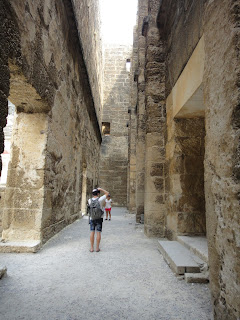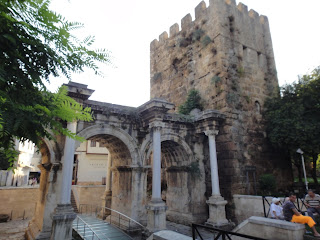About Me
Wednesday, 24 July 2013
Antayla to Fethiye along the Mediterranean
Antalya to Fethiye along the Mediterranean
The trip out of Antayla was along a beautiful coastal road and early in the morning
there was little traffic. We stopped for
breakfast at Kemer after riding for about 30 kilometers, and sorry we did, just
kilometers of wall to wall luxury hotels, we couldn’t see the beach. The road
then went inland and the next three days were an ordeal with high temperatures,
high humidity and high mountains. We
struggled up and down steep hills, dropping down to sea level only to have to
climb up again. Just before we got to Kas we had a very quick descent for
eleven kilometres. At Kas we took the
Lonely Planet’s advice and went to our first proper camping ground since we
left Australia, it had it's own private beach, restaurant and bar. We think our
little two man tent is small, but here all the other tents were smaller, people
really only using them to store their gear or to crawl into late at night.
People spent the day on sun lounges by the water in the shade, getting up very
early to secure their spot for the day or in some cases sleep on lounges if they
had a really good spot they did not want to lose. The over twentyfives yuppy
place to be for people from Istanbul. We enjoyed being able to swim and cool off, the water is a clear
blue, not cold, no waves,and no sand as the water laps against the rocky shore, to
step off the landing is to be in three metres of water. We spent a few days here
and then set off for Fethiye. Again we
had a lovely coastal road and then inland again but while the climbs were not
easy, they were nothing like we had experienced further back and we rode
shorter days because of the heat. Fethiye was another tourist town, the reason we went there was to see the Tomb of Amyntas, a temple façade carved into a sheer rock face dated 350 BC. There are tombs throughout the town, one in the middle of the street, the town was built around them. We had a rest here, if there was a train to Ephesus from here we probably would have taken it as the heat is oppressive and saps our energy, when it is this hot at home we stay in the shade. {Mad dogs and Englishmen} Like all tourist towns the world over, prices for tourists go up. Cafes and restaurants add 25% service charge, but it does not appear on the menu and no itemized account is given just the final amount, we can see why Mc Donalds are so busy. This was not the case earlier in Turkey so it took us by surprise.
We are in the middle of Ramadan, but you would not know it except for the firing of a cannon at the end of the day to signify that people can now eat. We have only seen one restaurant with a sign on to say it was shut through the day, all the rest are open and local people are eating. We are sure people not caught up in the tourist trade observe Ramadan more seriously. Also along the coast hardly a head scarf is seen and no veils.
Mustufa Kemel, the victorious leader at Gallipoli, is the national hero. He became president and was known as Ataturk “Father Turk” and nearly every town boasts a statue of him and his picture adorns shops, hotels and many houseThere are many, many hot houses here where tomatoes, peppers and melons are grown in the winter. There are so many they are like a blanket across the landscape.
Tuesday, 23 July 2013
The Mediterranean Coast and Antayla
We had a good bus ride from Avanos to Antayla and the bikes arrived safely this time. Antayla is situated on the Mediterranean Sea and was very busy with European tourists on summer holidays. We stayed in the old part of the city, once surrounded by a wall but very little remains of it. Emperor Hadrian visited the city here in 130AD and an arch was built in his honour and most of it still stands, now known as Hadrian’s Gate. In our hotel we met a young couple from Mt Isa, Ben and Lauren, who threw in their jobs and are now travelling. They were going to see the ruins we were planning to see and invited us to join them in their hire car and of course we accepted. The first ruins we visited were at Perge. We had visited the museum the day before and had seen the many statues that had been unearthed here so we tried to imagine them standing here before the city had become the ruins that it is today. The colonnaded streets are discernible and the remains of a nymphaeum stand at the end of the street. Built in the second century St Paul visited here on his missionary journeys. Next we went to visit Aspendos to see the theatre heralded as the best surviving example of theatres built by the Romans. It is dated as 160 AD. The seating is still intact and we sat on the seats just like thousands of others have done before us over 2000 years. It was possible to explore some of the tunnels which lead to the theatre and we wondered how many gladiators had walked those tunnels to the arena. The theatre is still used today for special performances, unfortunately none were occurring while we were there. The third cite was at Side, where ruins of an old city were right next to the ocean. The ruins here were widely scattered and not much restoration had been done .
Friday, 12 July 2013
Subscribe to:
Posts (Atom)



















































